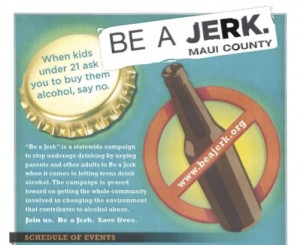 Hui Malama students participated in the 2012 “Be a Jerk” campaign, funded by Maui County and MEO. This post provides some background info, and a future post will show and tell more about Hui Malama Learning Center students’ involvement.
Hui Malama students participated in the 2012 “Be a Jerk” campaign, funded by Maui County and MEO. This post provides some background info, and a future post will show and tell more about Hui Malama Learning Center students’ involvement.
The County of Maui awarded grants of up to $2000 to local schools and community groups for actions in the “Be a Jerk” campaign during Alcohol Awareness Month in April.
One group worked to get the poster below displayed prominently in local stores, to discourage adults from buying alcohol for minors.
[gview file=”https://mauihui.org/wp-content/uploads/2012/05/Be-a-Jerk.pdf” save=”1″]
The following information is taken from a letter from Department of Housing and Human Concerns Deputy Director Jan Shishido, Volunteer Coordinator Wendy Stebbins, and Community Organizer Yuki Lei Sugimura:
“Be a Jerk” is an award-winning campaign launched to reduce youth access to alcohol by changing community practice, knowledge and policy. The campaign uses a model intervention called Community Mobillzing for Change on Alcohol (CMCA), which focuses on community organizing efforts to change the environment that contribute to the use of alcohol. These efforts target the entire community rather than individual young people.
“Be a Jerk” campaign actions aim to change these factors in our environment:
- Community NORMS: communicating a clear message to the community that underage drinking is inappropriate and unacceptable
- Accessibility & availability: reducing youth access to alcohol, both from social (home) and commercial settings
- Media messages: reducing advertising and promotions of alcohol directed at youth at stores and community/sports events
- Laws, rules, ordinances, and policies: change or introduce public and institutional policies that impact youth alcohol access (also includes home policies)
“Be a Jerk” campaign strategies and actions are designed through collaboration with community groups, service providers, schools, alcohol merchants and merchant associations, the media, local public officials, enforcement agencies, and other community institutions that influence the environment.
